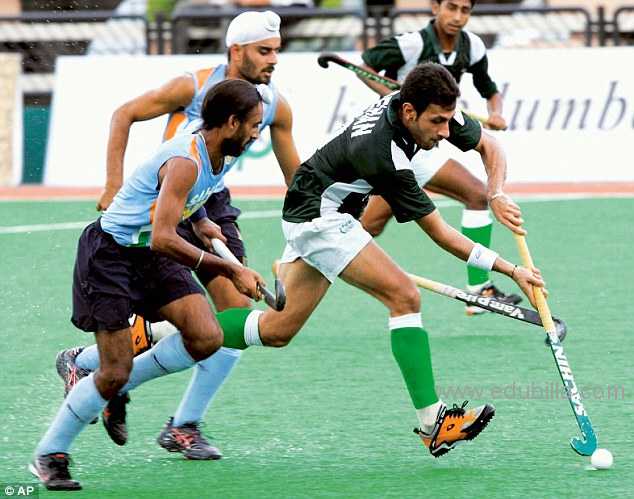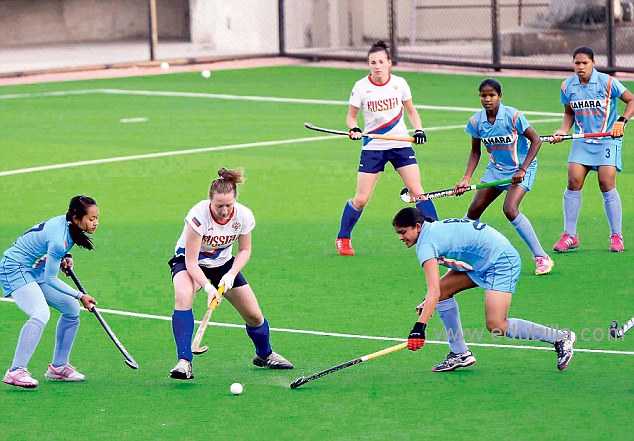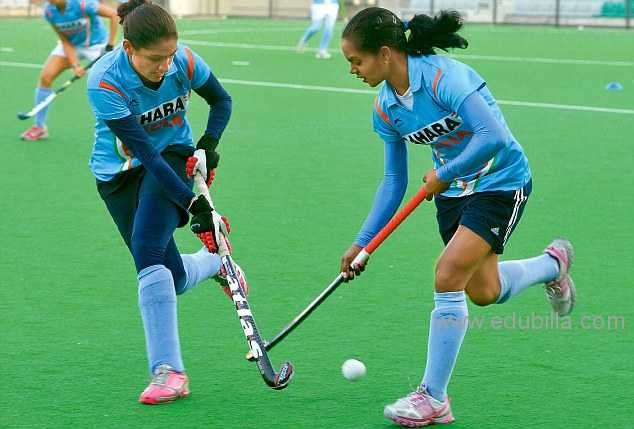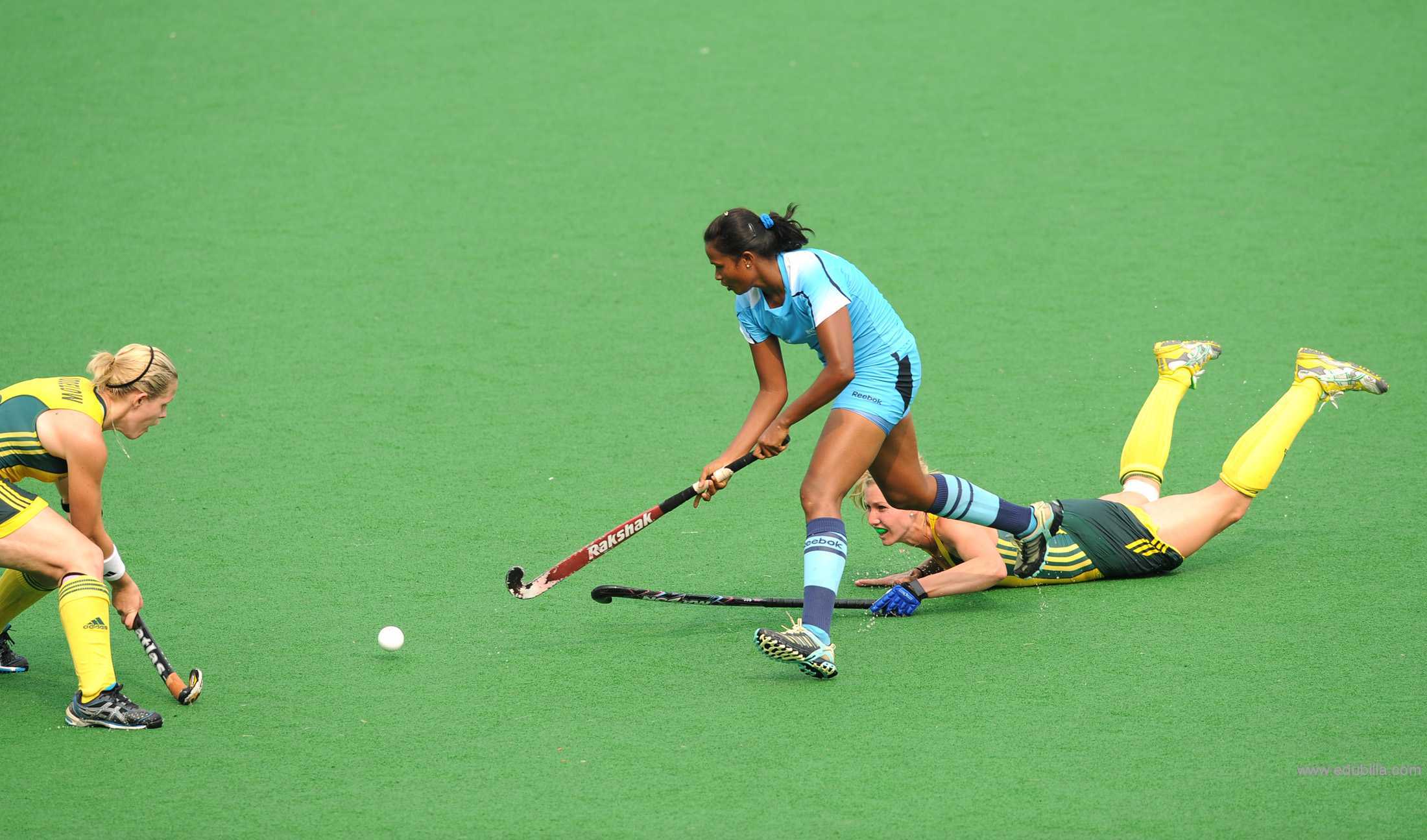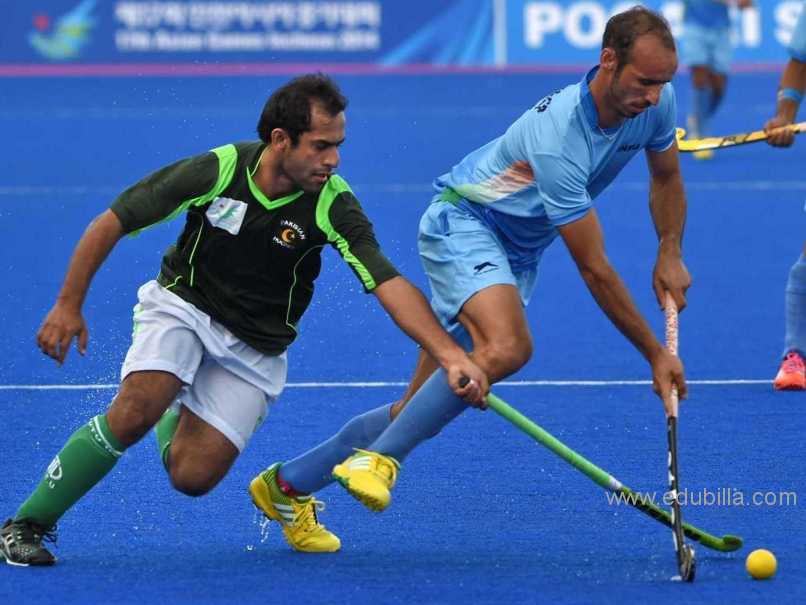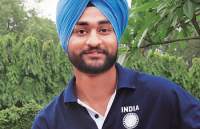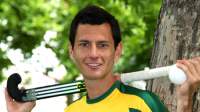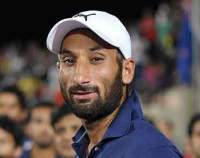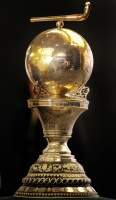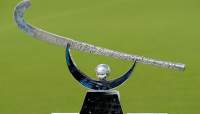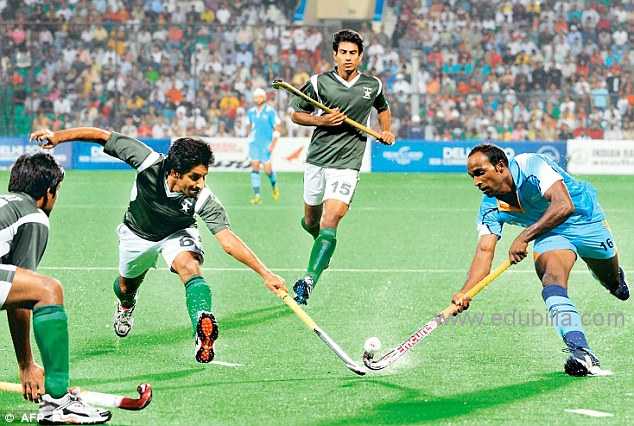
Overview Of Hockey
Hockey is a family of sports in which two teams play against each other by trying to maneuver a ball or a puck into the opponent's goal using a hockey stick. In many areas, one sport (typically field hockey or ice hockey) is generally referred to simply as hockey.
Hockey is a group of sports.There are three main ways that hockey is played.
-Field hockey is played with a ball on grass or astroturf. Teams have 11 players each. Field hockey is usually played outdoors, but there is indoor field hockey. Field hockey is played in the Summer Olympic Games.
-Roller hockey is played on a roller hockey rink, usually inside. Players on each team wear roller skates. They try to hit a small plastic disk called a hockey puck into the other team's goal. There are 5 players on each team. There is no contact.
Game Rules
Player:
One of the participants in a team.
Team:
A team consists of a maximum of sixteen persons composed of a maximum of eleven players on the field and up to five substitutes.
Field Player:
One of the participants on the fi eld other than the goalkeeper.
Goalkeeper:
One of the participants of each team on the fi eld who wears full protective equipment comprising at least headgear, leg guards and kickers and who is also permitted to wear goalkeeping hand protectors and other protective equipment.
Field Player with Goalkeeping Privileges:
One of the participants on the fi eld who does not wear full protective equipment but who has goalkeeping privileges ; this player wears a different colour shirt to their other team members as identifi cation.
Attack (Attacker):
The team (player) which (who) is trying to score a goal.
Defence (Defender):
The team (player) which (who) is trying to prevent a goal being scored.
Back-line:
The shorter (55 metres) perimeter line.
Goal-line:
The back-line between the goal-posts.
Side-line:
The longer (91.40 metres) perimeter line.
Circle:
The area enclosed by and including the two quarter circles
and the lines joining them at each end of the fi eld opposite
the centre of the back-lines.
Metres area:
The area enclosed by and including the line across the fi eld
22.90 metres from each back-line, the relevant part of the
side-lines, and the back-line.
Shot at goal:
The action of an attacker attempting to score by playing the ball towards the goal from within the circle.
The ball may miss the goal but the action is still a “ shot at goal ” if the player’s intention is to score with a shot directed towards the goal.
Hit:
Striking the ball using a swinging movement of the stick towards the ball.
Push:
Moving the ball along the ground using a pushing movement
of the stick after the stick has been placed close to the ball.
When a push is made, both the ball and the head of the
stick are in contact with the ground.
Flick:
Pushing the ball so that it is raised off the ground.
Scoop:
Raising the ball off the ground by placing the head of the
stick under the ball and using a lifting movement.
Forehand:
Playing a ball which is to the right of the player in a forwards direction.
The distance within which a player is capable of reaching the ball to play it.
Tackle:
An action to stop an opponent retaining possession of the ball.
Offence:
An action contrary to the Rules which may be penalised by
an umpire.
Detailed Hockey Rules Can Be Downloaded From Documents
Equipments Need For Hockey
Kicker:
A protective device worn by a goalkeeper and fastened over the front and sides of the shoe to allow him or her to kick the ball.
Pitch:
The playing field for hockey measuring 91.40m by 55m.
Stick:
A hook-shaped device made from wood and/or composite materials) with a flat face on the left side for hitting the ball.
Helmet (Goalie):
Used to protect head and face.
Elbow pads (Goalie):
Used to protect the goalkeeper's body.
Leg pads:
Used to protect the goalkeeper's body.
Shoe Blocker (Goalie):
Used to protect feet.
Shin Pads:
Used to protect shins.
Shoes:
Special shoes are worn to give good grip for running and turning.
Ball:
Made of hard plastic, usually white and with a circumference of approximately 230mm.
History Of Hockey
Games played with curved sticks and a ball can be found in the histories of many cultures. In Egypt, 4000-year-old carvings feature teams with sticks and a projectile, hurling dates to before 1272 BC in Ireland, and there is a depiction from approximately 600 BC in Ancient Greece where the game may have been called keretízein or kerhtízein because it was played with a horn or horn-like stick In Inner Mongolia, the Daur people have been playing beikou, a game similar to modern field hockey, for about 1,000 years.
Most evidence of hockey-like games during the Middle Ages is found in legislation concerning sports and games. The Galway Statute enacted in Ireland in 1527 banned certain types of ball games, including games using "hooked" (written "hockie", similar to "hooky") sticks.
By the 19th century, the various forms and divisions of historic games began to differentiate and coalesce into the individual sports defined today. Organizations dedicated to the codification of rules and regulations began to form, and national and international bodies sprung up to manage domestic and international competition.
Hockey in India:
Talking about hockey in India, the first hockey club came up in Calcutta in 1885-86 and soon Bombay and Punjab followed suit. Making its Olympic debut at the 1928 Amsterdam Games, Indian hockey team cruised home to its first Olympic gold, without conceding a single goal. The hallmark of this ruthless domination was the wizardry of Indian hockey legend - Dhyan Chand, who mesmerized the Amsterdam crowd with his dazzling skills. From 1928 to 1956, the Indian hockey juggernaut won six straight Olympic gold medals, while winning 24 consecutive matches. During this time, India scored 178 goals conceding only 7 in the process.
This was the golden era of Indian hockey, when India loomed large in world hockey and produced some of the finest players the game has ever seen. During this dominance, one name that clearly comes to mind is Balbir Singh. For almost three decades, Indian team had about five players with the same name. The first Balbir Singh played with the great Indian teams of 1948, 1952 and 1956. He reached the pinnacle of success at Helsinki in 1952 when he scored five goals in a 6-1 gold medal victory over the Netherlands. The four later Balbir Singhs played with the later Indian champions.
Etymology:
The first recorded use of the word "hockey" is from the 1773 book Juvenile Sports and Pastimes, to Which Are Prefixed, Memoirs of the Author: Including a New Mode of Infant Education, by Richard Johnson (Pseud. Master Michel Angelo), whose chapter XI was titled "New Improvements on the Game of Hockey".The belief that hockey was mentioned in a 1363 proclamation by King Edward III of England is based on modern translations of the proclamation, which was originally in Latin and explicitly forbade the games "Pilam Manualem, Pedivam, & Bacularem: & ad Canibucam & Gallorum Pugnam". The English historian and biographer John Strype did not use the word "hockey" when he translated the proclamation in 1720.
The word hockey itself is of unknown origin. One explanation is that it is a derivative of hoquet, a Middle French word for a shepherd's stave. The curved, or "hooked" ends of the sticks used for hockey would indeed have resembled these staves. Another explanation is that the cork bungs that replaced wooden balls in the 18th century came from barrels containing "Hock" ale, also called "Hocky"
Origin Of Hockey
Hockey was not invented by any one person or "born" in a Canadian village. Like many pastimes and sports, it evolved over centuries and was influenced by several groups and individuals from various countries.
Members of SIHR have long been involved in researching the origins of the game. In May of 2001, a Sub-Committee was formed to look into the claim that Windsor, Nova Scotia, was the Birthplace of Hockey. A claim that was advanced by Dr. Garth Vaughan in his book "The Puck Starts Here" and by the Windsor Hockey Heritage Society.
The following year in May of 2002, the sub-committee held a press conference at which time it produced a report which offers no opinion on the birth date or birthplace of hockey, but takes note of a game at Montreal's Victoria Skating Rink on March 3, 1875. This is the earliest eyewitness account known to the committee (in 2002) of a specific game of hockey in a specific place at a specific time, and with a recorded score, between two identified teams.
The committee went on to say that it hoped that its work would encourage further research into hockey's origins. The committee also acknowledged the part that Dr. Vaughan and the Windsor Hockey Heritage Society have played, generally, in stimulating an interest in the roots of Canada's national winter sport. Nova Scotia, after all, has been one of the leading contributors to hockey's development and growth from early times.
First indoor hockey game:
On March 3, 1875, the first recorded indoor ice hockey game took place at the Victoria Skating Rink in Montreal, Canada. Organized by James Creighton, who also captained one of the teams, the game was between two nine-member teams, using a wooden 'puck'. Members used skates and sticks used for outdoor hockey and shinny games in Nova Scotia, where Creighton was born and raised.
Original Six:
The Original Six is a term for the group of six teams that made up the National Hockey League (NHL) for the 25 seasons between the 1942–43 season and the 1967 NHL Expansion. These six teams are the Boston Bruins, Chicago Black Hawks, Detroit Red Wings, Montreal Canadiens, New York Rangers, and the Toronto Maple Leafs. All of the Original Six are still active franchises in the league.
The term, not contemporaneous to the era, originated as early as 1967, so that while only the Montreal and Toronto franchises existed in the NHL's inaugural 1917–18 season, the six existing teams going into the 1967-68 expansion to twelve teams were commonly considered as a traditional set.
Governing Bodies
International Basketball Federation:[FIH]
The International Hockey Federation, commonly known by the acronym FIH is the international governing body of field hockey and indoor field hockey. Its headquarters are located in Lausanne, Switzerland and president are Leandro Negre.FIH is responsible for field hockey's major international tournaments, notably the World Cup.
The FIH is Born:
Hockey took its most important step forward in 1924 when the International Hockey Federation, the world governing body for the sport, was founded in Paris under the initiative of Frenchman, Paul Leautey. Mr. Leautey, who would become the first President of the FIH, was motivated to action following hockey's omission from the program of the 1924 Paris Games.
Mr. Leautey called together representatives from seven National Federations to form the sport's international governing body, the Federation Internationale de Hockey sur Gazon. The six founding members, which represented both men's and women's hockey in their countries, were Austria, Belgium, Czechoslovakia, France, Hungary, Spain and Switzerland.
The FIH Mission:
Encourage, promote, develop and control hockey at all levels throughout the world
Support and maintain the ideals and objects of the Olympic movement and in particular the fight against doping
Exercise jurisdiction over and to determine disputes or disagreements between Members, between Continental Federations, between Members and Continental Federations, between Athletes and FIH and between Athletes and a Continental Federation
Establish and maintain an efficient administration
Preserve the independence of the FIH in all matters directly or indirectly concerning Hockey without the intervention of any outside authority; and
Conduct itself and take such administrative, financial or other actions as are necessary and in conformity with and in furtherance of its objects.
To Visit FIH Click Here
Awards Related To Hockey
Dhyan Chand Award:
Dhyan Chand Award is India's highest award for lifetime achievement in sports and games, given by the Ministry of Youth Affairs and Sports, Government of India.The award is named after the legendary Indian hockey player Dhyan Chand. The award was initiated in 2002. The award carries a cash prize of INR 500,000, a plaque and a scroll of honour.
Hart Memorial Trophy:
The Hart Memorial Trophy is an annual award given to the player judged to be the most valuable to his team. The winner is selected in a poll of the Professional Hockey Writers' Association in all NHL cities at the end of the regular season.
Vezina Trophy:
The Vezina Trophy is an annual award given to the goalkeeper adjudged to be the best at this position as voted by the general managers of all NHL clubs.
James Norris Memorial Trophy:
The James Norris Memorial Trophy is an annual award given to the defense player who demonstrates throughout the season the greatest all-round ability in the position. The winner is selected in a poll of the Professional Hockey Writers' Association at the end of the regular season.
Calder Memorial Trophy:
The Calder Memorial Trophy is an annual award given to the player selected as the most proficient in his first year of competition in the National Hockey League. The winner is selected in a poll of the Professional Hockey Writers' Association at the end of the regular season and each individual voter ranks their top five candidates on a 10-7-5-3-1 points system. Three finalists are named and the trophy is awarded at the NHL Awards ceremony after the playoffs.
Lady Byng Memorial Trophy:
The Lady Byng Memorial Trophy is an annual award given to the player adjudged to have exhibited the best type of sportsmanship and gentlemanly conduct combined with a high standard of playing ability.
The winner is selected in a poll of the Professional Hockey Writers' Association at the end of the regular season and each individual voter ranks their top five candidates on a 10-7-5-3-1 points system. Three finalists are named and the trophy is awarded at the NHL Awards ceremony after the Stanley Cup Playoffs.
Frank J. Selke Trophy:
The Frank J. Selke Trophy is an annual award given to the forward who best excels in the defensive aspects of the game.
The winner is selected in a poll of the Professional Hockey Writers' Association at the end of the regular season.
Jack Adams Award:
The Jack Adams Award is an annual award presented by the National Hockey League Broadcasters' Association to the NHL coach judged to have contributed the most to his team's success.
The winner is selected in a poll among members of the NHL Broadcasters' Association at the end of the regular season.
Bill Masterton Memorial Trophy:
The Bill Masterton Memorial Trophy is an annual award under the trusteeship of the Professional Hockey Writers' Association and is given to the National Hockey League player who best exemplifies the qualities of perseverance, sportsmanship, and dedication to hockey.
The winner is selected in a poll of all chapters of the PHWA at the end of the regular season.
Ted Lindsay Award (formerly Lester B. Pearson Award):The Ted Lindsay Award is presented annually to the "most outstanding player" in the NHL as voted by fellow members of the National Hockey League Players' Association.
The award was first handed out at the conclusion of the 1971–72 NHL season. It honors Hall of Famer Ted Lindsay, an All-Star forward known for his skill, tenacity, leadership, and for his role in establishing the original Players' Association.
NHL Foundation Award:
The NHL Foundation Player Award is awarded annually to the National Hockey League (NHL) player "who applies the core values of (ice) hockey—commitment, perseverance and teamwork—to enrich the lives of people in his community".
Eleven players have won the NHL Foundation Player Award since its inception. Kelly Chase was awarded the inaugural NHL Foundation Player Award in 1998. No player has ever won the award twice, nor has any team been represented twice by winners.
Sample Documents Of Hockey
-Viswanathan Anan

